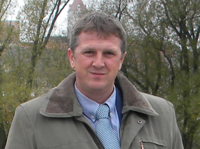
Nume: FODOREAN Florin Gheorghe
Tema: Echo. A comunica în Antichitate. Cazul Daciei romane
Partener: Academia Română, Filiala Cluj Institutul de Arheologie şi Istoria Artei, Cluj-Napoca
Proiect: Dynamics of a Society: Space, Infrastructure, Travel and Mobility in Roman Dacia
Date de contact
fodorean_f@yahoo.com
Education
- 2004 – Present: ASSISTANT PROFESSOR, Ph.D. in the Department of Ancient History and Archaeology, Faculty of History and Philosophy, Babeș-Bolyai University Cluj-Napoca. Areas of interest: Roman archaeology, Roman topography, Roman roads, history of cartography (ancient and modern maps, digital maps), topography, GIS.
- 15 Nov. 1999 – 15. Nov. 2003: Ph. D. Candidate, Faculty of History and Philosophy, Department of Ancient History and Archaeology. Title of doctoral thesis: "THE ROADS OF ROMAN DACIA". Supervisor: prof. dr. Mihai Bărbulescu.
- 1999-2000 – MA diploma, specialization Roman archaeology. Subject of dissertation: The Roman roads from Dacia Porolissensis (supervisor prof. dr. Mihai Bărbulescu).
- 1995 – 1999: student, "Babeş-Bolyai" University Cluj-Napoca, Faculty of History and Philosophy. BA subject: The Roman fortresses from the North-Western frontier of Dacia Porolissensis.
Dynamics of a Society: Space, Infrastructure, Travel and Mobility in Roman Dacia
Communication is essential for the development of civilizations. In the absence of elements that provide the opportunity to change information of any kind, a society became self-isolated. The Roman Empire, through its general policy, understood this perfectly. Communication is done ‘physically’ by infrastructure, which provides opportunities for goods and people to travel, to organize a territory, but also the access to information, actually the total control. Information means power. To administrate a huge territory, the emperors of Rome have understood exactly to invest human and financial resources into an idea and to support it so strongly: the creation of communication infrastructure.
In the classical literature have emerged and spread opinions without scientific basis or insufficiently argued regarding: the perception of space in the Roman Empire, the role of itineraries, the level of the geographical knowledge, the higher costs related to land transport or the existence of Roman scale maps. More seriously, enough historians have imagined the Roman Empire as a space of static communities. In the last years, only few researchers had the courage to change this traditionalist approach and look things differently, starting from simple questions: What meant a travel in the Roman era, how one could plan it, how was realized, which were the benefits, but also the risks, hazards? How Romans did perceive their own geographical area? How understood they time and distance? How information was spread? How officials travelled? How ordinary citizens travelled? The project is focused on all the key aspects relating to ‘means’ that assured the communication within the Roman Empire: 1. human resources (travel of officials, of individuals, merchants, soldiers, reasons for travel: personal, business, leisure etc.). 2. technical means, where we will discuss the organization of the transport system in Roman Dacia, the distance and time required to perform certain movements (with examples), organizing a travel (which involve the use of itineraria, the use of certain road sections, the use of information offered by Roman milestones), the dangers of travel.
Our main topics are: 1. Geographical space in Roman times. Sources. Perceptions. Mentality. Education and geographical information: the level of knowledge. Preparation of surveyors; 2. Planning a travel - resources in Roman times: itineraria, milliaria, ‘official’ roads and routes; 3. Organizing communication in Dacia - the public transport system (cursus publicus). Routes. Stops. Funding. Staff involved. Travelling under imperial ‘protection’; 4. Soldiers and moving troops. Identities ‘transformed’ or maintained. The concept of ‘unified space’; 5. Trade and travel. Business travels. Dacian products to Empire. Imports. Trade routes. Rome as a model of organization: the supply with grain; 6. Types of travel and travel motivations. From ‘embassies’ to private persons; 7. Circulation of products in Roman Dacia. Internal transport by land and by water. Trade routes. Logistic organization and maintenance of road sections; 8. Dacia and the Roman Empire. Strategic position and integration in the general communication system. Geography, topography and organization of the road network; 9. Economy, settlements and communications. A complementary system; 10. Distances and time. Speed between the official records and everyday realities. ‘Tangible’ areas. 11. Models of regional development based on the transport infrastructure in Dacia. Case study: Potaissa and surroundings. 12. From itineraria to geographic realities: travelling in Roman times.
Publicatii
Books
- 1. Fodorean, F. (2006): Drumurile din Dacia romană (The roads of Roman Dacia). Cluj-Napoca. Napoca Star Publishing House, Cluj-Napoca, 2006, 448 p., XV plates, 69 figures in text, 3 tables, 24 x 17 cm format, 16 pages of English summary (433-448), ISBN 973-647-372-4.
- 2. Fodorean, F. (2005): Drumurile la romani (The roads of Romans). Cluj-Napoca. Ed. Napoca Star. 157 p. ISBN 973-647-243-4
- 3. Bărbulescu, M., Bărbulescu, C., Fodorean, I., Fodorean, F., Husar, A., Mihăilă, C., Nemeth, E., Nemeti, I., Nemeti, S., Pîslaru, M., Sălăşan, M., Zotic, V. (2005). Atlas-dicţionar al Daciei romane (Dictionary-atlas of Roman Dacia). Cluj-Napoca. Ed. Tribuna. 148 p.
Selected articles:
- 1. Fodorean, F. (2006). Le strade della Dacia romana (II), in Quaderni Catanesi di studi antichi e medievali, N.S. 4-5, 165-344.
- 2. Fodorean, F. (2005). Le strade della Dacia romana (I), in Quaderni Catanesi di studi antichi e medievali, N.S. 3, 331-446.